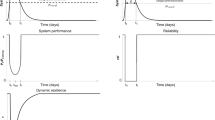Abstract
A methodology to assess and track changes in the hazard functions between water main breaks are developed by using the proportional hazards model. For this purpose, the risk sets for the estimation of the parameters of the proportional hazards model are redefined for each break interval. The methdology provides a systematic framework for analyzing changes of the hazard functions of water mains as more breaks occur. Therefore, a progression of the hazard function can be examined as the number of pipe breaks increases, and a critical point, at which the hazard function changes to a different functional form, e.g. from an exponential to a constant hazard, can be obtained to distinguish different stages of pipe failure.
Similar content being viewed by others
References
Andreou, S.A., Marks, D.H., and Clark, R.M. (1987a). “A new methodology for modeling break failure patterns in deteriorating water distribution systems: Theory.”Advances in Water Resources, Vol. 10, pp. 2–10.
Andreou, S.A., Marks, D.H., and Clark, R.M. (1987b). “A new methodology for modeling break failure patterns in deteriorating water distribution systems: Applications.”Advances in Water Resources, Vol. 10, pp. 11–20.
Brémond, B. (1997).Statistical modelling as help in network renewal decision European commission co-operation on science and technology (COST), Committe C3-diagnostics of urban infrastructure, Paris, France.
Breslow, N.E. (1974). “Covariance analysis of censored survival data.”Biometrics, Vol. 30, pp. 89–99.
Clark, R.M., Stafford, C.L., and Goodrich, J.A. (1982). “Water Distribution Systems: A spatial and cost evaluation.”Journal of Water Resources Planning and Management Division, ASCE, Vol. 108, No. 3, pp. 243–256.
Constantine, A.G. and Darroch, J.N. (1993). In S. Osaki, D. N. P. Murthy (Eds.),Pipeline Reliability: Stochastic models in engineering technology and management. Singapore, World Scientific.
Constantine, A.G., Darroch, J.N., and Miller, R. (1996).Predicting underground pipe failure, Australian Water Works Association.
Cox, D.R. (1972). “Regression models and life tables.”Journal of Royal Statistic Society, Vol. 34, Series B, pp. 187–220.
Cox, D.R. and Oaks, D. (1984).Analysis of Survival Data. Chapman and Hall, London.
Deb, A.K., Hasit, Y., Grablutz, J.F.M., and Herz, R.K. (1998). “Quantifying future rehabilitation and replacement needs of water mains.” AWWA Research Foundation, Denver, Colorado, USA.
Eisenbeis, P., Rostum, J., and Le Gat, Y. (1999). “Statistical models for assessing the technical state of water networks Some European experiences.”Proceedings of the AWWA Annual Conference, Chicago, USA.
Goulter, I.C. and Kazemi, A. (1988). “Spatial and temporal groupings of water main pipe breakage in Winnipeg.”Canadian Journal of Civil Engineering, Vol. 15, No. 1, pp. 91–97.
Goulter, I.C., Davidson, J., and Jacobs, P. (1993). “Predicting water main breakage rate.”Journal of Water Resources Planning and Management, ASCE, Vol. 119, No. 4, pp. 419–436.
Gustafson, J.M. and Clancy, D.V. (1999b). “Using Monte-Carlo simulation to develop economic decision criteria for the replacement of cast iron water mains.”Proceedings of the AWWA Annual Conference, Chicago, USA.
Herz, R.K. (1996). “Ageing process and rehabilitation needs of drinking water distribution networks.”Journal of Water SRT-Aqua, Vol. 45, No. 5, pp. 221–231.
Jacobs, P. and Karney, B. (1994). “GIS development with application to cast iron water main breakage rate.”2nd International conference on water pipeline systems, BHR Group Ltd, Edinburgh Scottland.
Kalbfleisch, J.D. and Prentice, R.L. (1980).The statistical analysis of failure time data. Wiley, New York.
Kettler, A.J. and Goulter, I.C. (1985). “An analysis of pipe breakage in urban water distribution networks.”Canadian Journal of Civil Engineering, Vol. 12, pp. 286–293.
Klein, J.P. and Moeshberger, M.L. (1997).Survival analysis: techniques for censored and truncated data. Springer, New York.
Kleiner, Y. and Rajani, B. (2001). “Comprehensive review of structural deterioration of water mains: statistical models.”Urban Water, Vol. 3, pp. 131–150.
Kulkarni, R.B., Golabi, K., and Chuang, J. (1986). “Analytical techniques for selection of repair-or-replace options for cast iron gas piping systems-Phase I.” as Research Institute, PB87-114112, Chicago, IL. USA.
Lei, J. (1997).Statistical approach for describing lifetimes of water mains Case Trondheim Municipality, Report No. 22F007.28, SINTEF Civil and Environmental Engineering, Trondheim, Norway.
Li, D. and Haims, Y.Y. (1992a). “Optimal maintenance-related decision making for deteriorating water distribution systems 1. Semi-Markovian model for a water main.”Water Resources Research, Vol. 28, No. 4, pp. 1053–1061.
Marks, H.D.et al. (1985).Predicting urban water distribution management strategies: A case study of New Haven Connecticut. US Environmental Protection Agency (Co-operative Agreement R8 1 0558-01-0).
Marks, H.D., Andreou, S. Jeffrey, L., Park, C., and Zaslavski, A. (1987).Statistical models for water main failures. US Environmental Protection Agency (Co-operative Agreement CR810558) M.I.T. Office of Sponsored Projects No. 94211. Boston, MA, USA.
McMullen, L.D. (1982). “Advanced concepts in soil evaluation for exterior pipeline corrosion.”Proceedings of the AWWA Annual Conference, Maimi, USA.
Mavin, K. (1996).Predicting the Failure Performance of Individual Water Main, Research Report No. 114, Urban Water Research Association of Australia, Melbourne, Australia.
Rajani, B. and Kleiner, Y. (2001). “Comprehensive review of structural deterioration of water mains: physically based models.”Urban Water, Vol. 3, pp. 151–164.
Shamir, U. and Howard, C.D.D. (1979). “An analytic approach to scheduling pipe replacement.”Journal of AWWA, Vol. 71, No. 5, pp. 248–258.
Walski, T.M. and Pelliccia, A. (1982). “Economic analysis of water main breaks.”Journal of AWWA, Vol. 74, No. 3, pp. 140–147.
Author information
Authors and Affiliations
Corresponding author
Rights and permissions
About this article
Cite this article
Park, S. Identifying the hazard characteristics of pipes in water distribution systems by using the proportional hazards model: 1. Theory. KSCE J Civ Eng 8, 663–668 (2004). https://doi.org/10.1007/BF02823557
Received:
Accepted:
Issue Date:
DOI: https://doi.org/10.1007/BF02823557




